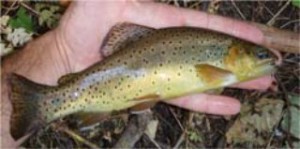The Apache Trout is one of Arizona’s two native trout species and is the Arizona state fish. Body color is yellowish-gold at the top of the head and the back is a dark olive. Dorsal, anal and pelvic fins are white tipped with dark, bold spots on dorsal and tail fin.
Spotting on the body is sparse and irregular and may extend below lateral line. Two small black spots on either side of pupil give appearance of black stripe through eye. Length: 6 to 24 inches. Weight: 6 ounces to almost 6 pounds.
Apache Trout Location and Habitat
Found only in White Mountain lakes and streams on forest and reservation lands.
Reproduction
Apache trout typically spawn in early spring. Females excavate redds (nests) in the gravel, after fertilization the eggs are covered with gravel. Generally sexually mature by age 3. Apache trout are capable of hybridizing with rainbow trout which has greatly reduced the range of pure strain Apaches.
Food
They feed on aquatic and terrestrial insects and invertebrates.
Table Quality
The meat is firm, flaky and is considered fine eating. Removal of fine bones is difficult if fish is overcooked.
Angling Methods
Apache trout can be caught by a variety of methods, including wet or dry flies, small lures, or natural baits, in either lakes or streams. However, artificial flies produce the best results.
Wet Flies – Small hooks, in sizes 14 through 18, are usually better for Apache trout, especially throughout the day. Use patterns that have olive green, brown, or black coloring. Popular patterns include: Peacock Ladies; Pheasant-tail nymphs; Hares Ear nymphs; zug bugs; scuds; or stonefly, mayfly or caddis fly nymph imitations. Larger wet flies (size 6 to 8 hooks) that work well include: wooly buggers, wooly worms, streamers, and muddler minnows. Colors in purple, black, brown, and green work best.
Dry Flies – Again, use small hook sizes. Best fishing times are at dawn and dust, or any other time fish are rising to the surface to feed. Popular patterns include: Royal Coachman; Adams; Royal Wulff; Parachute Adams; or any gnat, mosquito, mayfly caddisfly, or stonefly adult imitations.
Terrestrial Patterns – Use any grasshopper, ant, or beetle imitation. Pay attention to size when fishing hopper patterns.
Lures – Smaller spinners work best. Some to try are: Panther Martins, Super Dupers, or Rooster Tails.
Baits – Generally, bait will work to catch Apache trout if it looks natural. Use worms or grasshoppers. Some prepared baits can work at times.

